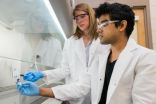(Press-News.org) Throughout our lives, our brains adapt to what we learn and memorise. The brain is indeed made up of complex networks of neurons and synapses that are constantly re-configured. However, in order for learning to leave a trace, connections must be stabilized. A team at the University of Geneva (UNIGE) discovered a new cellular mechanism involved in the long-term stabilization of neuron connections, in which non-neuronal cells, called astrocytes, play a role unidentified until now. These results, published in Current Biology, will lead to a better understanding of neurodegenerative and neurodevelopmental diseases.
The central nervous system excitatory synapses – points of contact between neurons that allow them to transmit signals – are highly dynamic structures, which are continuously forming and dissolving. They are surrounded by non-neuronal cells, or glial cells, which include the distinctively star-shaped astrocytes. These cells form complex structures around synapses, and play a role in the transmission of cerebral information which was widely unknown before.
Plasticity and Stability
By increasing neuronal activity through whiskers stimulation of adult mice, the scientists were able to observe, in both the somatosensory cortex and the hippocampus, that this increased neuronal activity provokes an increase in astrocytes movements around synapses. The synapses, surrounded by astrocytes, re-organise their architecture, which protects them and increases their longevity. The team of researchers led by Dominique Muller, Professor in the Department of Fundamental Neuroscience of the Faculty of Medicine at UNIGE, developed new techniques that allowed them to specifically "control" the different synaptic structures, and to show that the phenomenon took place exclusively in the connections between neurons involved in learning. "In summary, the more the astrocytes surround the synapses, the longer the synapses last, thus allowing learning to leave a mark on memory," explained Yann Bernardinelli, the lead author on this study.
This study identifies a new, two-way interaction between neurons and astrocytes, in which the learning process regulates the structural plasticity of astrocytes, who in turn determine the fate of the synapses. This mechanism indicates that astrocytes apparently play an important role in the processes of learning and memory, which present abnormally in various neurodegenerative and neurodevelopmental diseases, among which Alzheimer's, autism, or Fragile X syndrome.
This discovery highlights the until now underestimated importance of cells which, despite being non-neuronal, participate in a crucial way in the cerebral mechanisms that allow us to learn and retain memories of what we have learned.
INFORMATION: END
How the brain stabilizes its connections in order to learn better
2014-07-17
ELSE PRESS RELEASES FROM THIS DATE:
NASA's Aqua satellite sees birth of Tropical Depression 10W
2014-07-17
The tenth tropical depression of the Northwestern Pacific Ocean was born as NASA's Aqua satellite passed overhead.
NASA's Aqua satellite passed over Tropical Depression 10W on July 17, as it came together northwest of the island of Yap. As Aqua passed overhead the Atmospheric Infrared Sounder (AIRS) instrument aboard captured infrared data that showed powerful thunderstorms developed around the storm's center. When AIRS gathered the data on the cloud tops, the temperatures were already as cold as -63F/-52C, indicating strong uplift has pushed them to the top of the troposphere.
At ...
NASA's TRMM satellite adds up Typhoon Rammasun's Philippines deluge
2014-07-17
Typhoon Rammasun dropped large amounts of rainfall over the Philippines, and the TRMM satellite was used to measure it from space. Rammasun is now making its way toward Hainan Island, China.
NASA and the Japanese Aerospace Exploration Agency partner on the Tropical Rainfall Measuring Mission or TRMM satellite. As TRMM orbits the Earth it has the ability to calculate rainfall occurring in storms and a rainfall analysis using TRMM and other data helps scientists calculate total rainfall.
A preliminary analysis of rainfall during the period when typhoon Rammasun was moving ...
Scientists track gene activity when honey bees do and don't eat honey
2014-07-17
CHAMPAIGN, Ill. — Many beekeepers feed their honey bees sucrose or high-fructose corn syrup when times are lean inside the hive. This practice has come under scrutiny, however, in response to colony collapse disorder, the massive -- and as yet not fully explained -- annual die-off of honey bees in the U.S. and Europe. Some suspect that inadequate nutrition plays a role in honey bee declines.
In a new study, described in Scientific Reports, researchers took a broad look at changes in gene activity in response to diet in the Western honey bee (Apis mellifera), and found ...
Measuring nurture: Study shows how 'good mothering' hardwires infant brain
2014-07-17
By carefully watching nearly a hundred hours of video showing mother rats protecting, warming, and feeding their young pups, and then matching up what they saw to real-time electrical readings from the pups' brains, researchers at NYU Langone Medical Center have found that the mother's presence and social interactions — her nurturing role — directly molds the early neural activity and growth of her offsprings' brain.
Reporting in the July 21 edition of the journal Current Biology, the NYU Langone team showed that the mother's presence in the nest regulated and controlled ...
Scripps Florida scientists identify gene that plays a surprising role in combating aging
2014-07-17
JUPITER, FL, July 17, 2014 – It is something of an eternal question: Can we slow or even reverse the aging process? Even though genetic manipulations can, in fact, alter some cellular dynamics, little is known about the mechanisms of the aging process in living organisms.
Now scientists from the Florida campus of The Scripps Research Institute (TSRI) have found in animal models that a single gene plays a surprising role in aging that can be detected early on in development, a discovery that could point toward the possibility of one day using therapeutics, even some commonly ...
Crohn's disease research
2014-07-17
University of Delaware researchers have identified a protein, hiding in plain sight, that acts like a bodyguard to help protect and stabilize another key protein, that when unstable, is involved in Crohn's disease. The fundamental research points to a possible pathway for developing an effective therapy for the inflammatory bowel disease.
The research, by Catherine Leimkuhler Grimes, assistant professor of chemistry and biochemistry at UD, and Vishnu Mohanan, doctoral student in biological sciences, is published in the July 4 issue of the Journal of Biological Chemistry. ...
Carnegie Mellon combines hundreds of videos to reconstruct 3D motion without markers
2014-07-17
PITTSBURGH—Carnegie Mellon University researchers have developed techniques for combining the views of 480 video cameras mounted in a two-story geodesic dome to perform large-scale 3D motion reconstruction, including volleyball games, the swirl of air currents and even a cascade of confetti.
Though the research was performed in a specialized, heavily instrumented video laboratory, Yaser Sheikh, an assistant research professor of robotics who led the research team, said the techniques might eventually be applied to large-scale reconstructions of sporting events or performances ...
Incidence of stroke in the elderly has dropped by 40 percent over the last 20 years
2014-07-17
Philadelphia, PA, July 17, 2014 – A new analysis of data from 1988-2008 has revealed a 40% decrease in the incidence of stroke in Medicare patients 65 years of age and older. This decline is greater than anticipated considering this population's risk factors for stroke, and applies to both ischemic and hemorrhagic strokes. Investigators also found death resulting from stroke declined during the same period. Their findings are published in the July issue of The American Journal of Medicine.
Preventable but deadly, stroke is the fourth leading cause of mortality in the ...
NYU Langone investigators to present new research at 2014 Alzheimer's Association International Conference
2014-07-17
(New York, NY, July 12, 2014) - Researchers from the Center for Cognitive Neurology (CCN) at NYU Langone Medical Center, NYU School of Medicine, and the Nathan S. Kline Research Institute will present new findings at the 2014 Alzheimer's Association International Conference in Copenhagen, Denmark, July 12 – 17, 2014.
The Center for Cognitive Neurology is a multidisciplinary, integrated center devoted to research, clinical care and clinical advances toward the treatment and cure of neurological diseases affecting cognition -- focused on memory, language, attention, auditory, ...
The rate at which groundwater reservoirs are being depleted is increasing
2014-07-17
FRANKFURT.In what parts of the world and to what degree have groundwater reservoirs been depleted over the past 50 years? The Frankfurt hydrologist Prof. Petra Döll has been researching this using the global water model WaterGAP. She has arrived at the most reliable estimate to date by taking into consideration processes which are important in dry regions of the world. The values calculated were compared with monitoring data from many different wells and data from the GRACE satellites. These satellites measure changes in the Earth's gravity field. Döll has come to the conclusion ...




